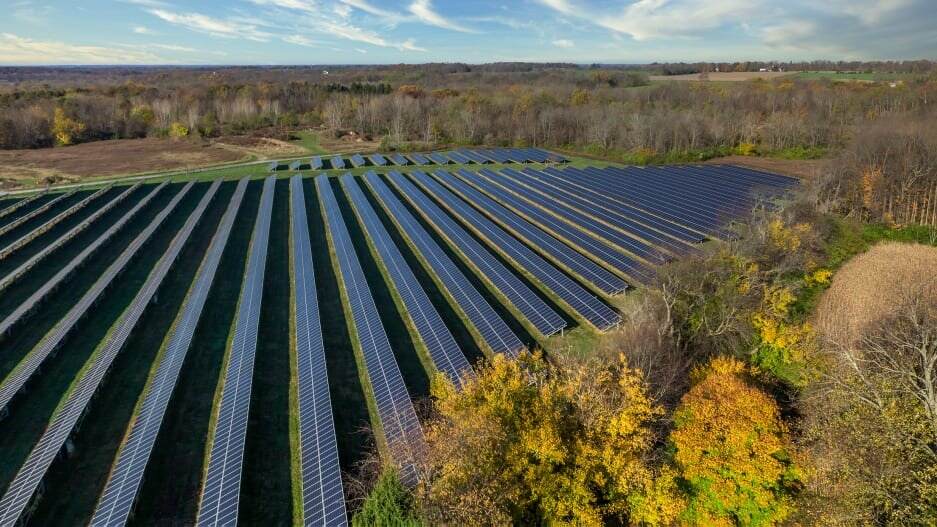- | 9:00 am
Why you really don’t need to worry about solar panel waste or health effects
When it comes to solar power development, there’s a disconnect between what experts know and what the public worries about.

This article by Dan Gearino originally appeared on Inside Climate News. It is republished with permission. Sign up for its newsletter here.
Having sat in many community hearings about solar power development, I am used to vivid descriptions of how photovoltaic panels might as well be dripping with harmful substances that will sicken people and livestock.
The concerns are pervasive, but almost completely separate from reality.
For example, one of the recurring issues raised against solar development is the presence of cadmium in photovoltaic panels. But researchers have shown that cadmium is present in only a small share of panels; it makes up 0.1% or less of the mass of the panels in which it’s present; and the form of cadmium sometimes used in panels is different and safer than the form that leads to health concerns.
Annick Anctil, an engineering professor at Michigan State University, knows this research because she’s done a lot of it herself. And she can see that there is a disconnect between what experts know and what the public worries about.
“The fact is, we haven’t communicated that information very well to a large audience,” she said.
I got in touch with her this week to get her thoughts on a new opinion essay published in the journal Nature Physics that is a brief debunking of many of the major concerns about the toxicity of solar panels and the growing volume of panel waste.
Anctil says the essay, written by a team that includes people from the National Renewable Energy Laboratory and the Colorado School of Mines, gets the science right and has a clarity that could be a step toward increasing public understanding of health and safety issues related to solar power. (She wasn’t a coauthor, although she knows several of the coauthors.)
Here are some of the main points:
- Concerns about an increase in solar panel waste need to be placed in the context of how the amount of waste compares to other sources. Projections of panel waste are “a drop in the ocean,” the authors say, compared to waste categories like plastics, coal ash, and municipal solid waste, and are also much less than e-waste like old phones and computers. The vast quantity of waste from all those sources is a concern and we need to find ways to reduce waste, but solar panels are not a major issue in that larger conversation.
- Solar panels do not contain harmful levels of the toxic materials that often get discussed at public hearings about development. The authors found no examples of solar panels for utility-scale development that contain arsenic, gallium, germanium, or hexavalent chromium. A small share of panels contain trace amounts of cadmium, but this is a form of the metal that is stable and not a danger to human health.
- The solar industry is taking a variety of steps to reduce waste and concerns about toxicity by extending the lifespan of panels, finding alternatives for certain materials and working on efficient ways to recycle panel components. The hope is that these efforts will mean that the actual amount of waste will be less than current estimates.
One thing I’ll add: Solar developers are responsible for decommissioning projects when they reach the end of their lives, and they often have to post a bond at the time of construction to cover the costs of an eventual teardown and restoration of land. If a company sells a project or goes out of business, regulators have a process for determining who inherits responsibility for decommissioning. Community leaders are often concerned about getting stuck with the costs of decommissioning, but there are straightforward ways to make sure that the people making money from the development are on the hook for those costs.
“We’re trying to address some of what to us seems like the biggest concerns that really need scientific data behind them, such as toxicity, the amount of waste, things like that,” said Heather Mirletz, the lead author and a PhD candidate at the Colorado School of Mines and the National Renewable Energy Laboratory.
The paper is not new research. Instead, it is a compilation of the work of a variety of other researchers, designed to make a case about the safety of solar panels.
If I was a solar developer, I would print thousands of copies of this three-page piece and hand them to everybody at local hearings.
In those hearings, people who oppose projects will often talk about health concerns, reading things they got from internet searches or by sharing talking points from groups that oppose nearly all solar development. There are many examples in my reporting last year about opposition to solar projects in Ohio, including one instance of a county health official repeating some of the dubious claims.
Some of this is intentionally misleading, but I think it’s a mistake to say that most opposition to development is being done with ill intent. Many people are looking for good answers to their questions about health and safety.
Also, I want to make clear that there is a difference between saying that some health concerns about solar are inaccurate and saying that there are zero concerns.
Researchers like Anctil spend their days probing these questions, and she is careful to specify that her findings are based on currently available data, and that the body of knowledge on this subject will continue to grow.
One of the big challenges as we enter a period of rapid growth in development is to explain what researchers know in a way that’s easy to understand.






































